Vintage photos, C&S engine 9 and caboose 312/1009, c1909-11
Vintage photos, C&S engine 9 and caboose 312/1009, c1909-11
|
This post was updated on .
Doug Heitkamp always has a knack for finding early C&S photos, never published, then generously sharing them with us on this forum.
In this spirit, I was fortunate to acquire two early tourist snapshots of C&S equipment dating to somewhere around 1909-1911, and would like to post them for your enjoyment and discussion. 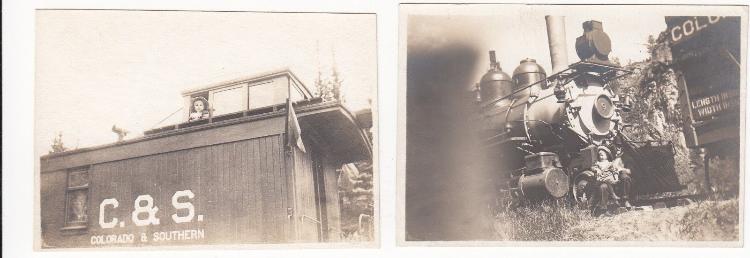 The photos are small, and appear to be contact prints made from 120 orthochromatic roll film, as the image size is 2 1/8 by 3 1/8 inches. They were likely shot by a tourist on summer vacation somewhere along the C&S. The image size would be compatible with a Kodak "Brownie No 2", a popular camera of that era that was first marketed in 1901, the first Brownie to use 120 roll film:  The photos are undated, but have sequential numbers in pencil on the back, possibly negative numbers from the Kodak processor and printer. While smaller than a business card, it is thrilling to hold someone's keepsake mementoes from over a hundred years ago! Both photos are of a little girl (I think) posed on locomotive number 9 and in the cupola of caboose number 312 or 1009 depending on the date of the actual photo. Enlargements at 1200 dbi. First number 9:  The little girl is seated on the lap of her derby-hatted father/uncle/grandfather, who is in turn seated on the pilot of number 9, idle on a siding, spotted near a stock car. Number nine's appearance and the stock car tend to date the photos to 1909-1911, in my opinion. The stock car has the block C&S lettering, there is no stirrup step or grab iron on the car end and the height of the lowest slat is about that of the side sill, consistent with the phase 2 Bettendorf trucked stock cars delivered in November, 1907. So the photo likely dates from summer 1908 at earliest (caboose rebuilds didn't start until 1908) and must be before 1916, by which date USSA hardware was applied to the freight cars. Number nine still has a wood pilot, with wood pilot beam and no pilot deck. The sand dome still has a single gravity sand pipe--the modern sanders began showing up in 1910 or 1911. The head light bracket has been moved part way out over the pilot frame, with a wrap around handrail, but isn't cantilevered "way out" over the pilot yet; there is a little forward facing number plate atop the headlight, all consistent with 1908-1910. The boiler jacket and dome tops/saddles have a sheen that suggests a Russian or planished iron finish. In fact it looks very much like number 9 in two DPL McClure photos dated to about 1910, below. One curiosity about the headlight on number 9: There appears to be a circular metal "cake pan" like cover over the headlight, secured with set screws or bolts, to protect the front glass. I've never noticed this before, only screens on other locomotives that were pulled down, like window shades, from the small horizontal housing atop the headlight. 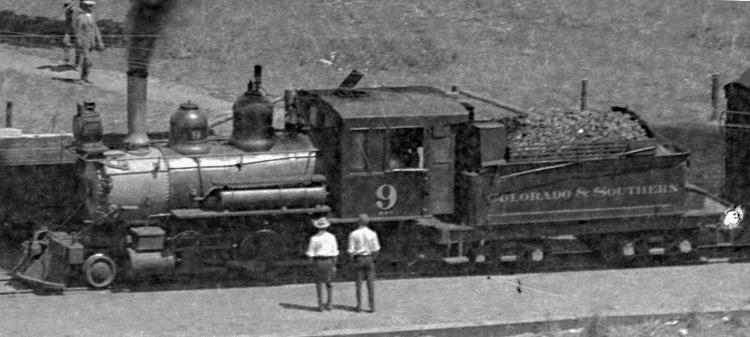
<a href="http://">http://digital.denverlibrary.org/cdm/singleitem/collection/p15330coll22/id/329/rec/4 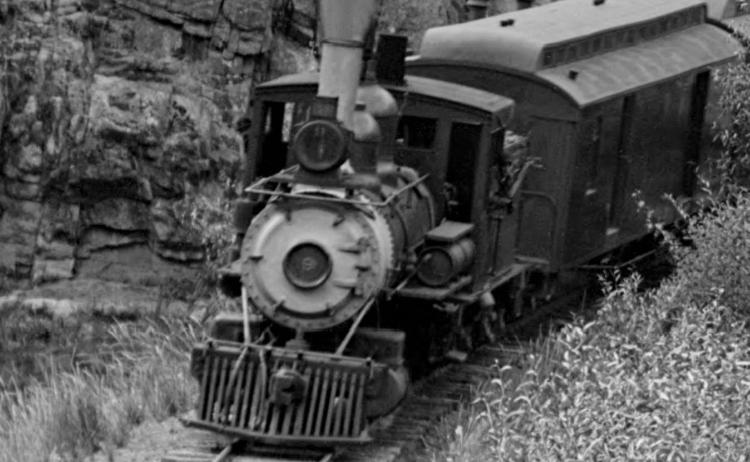 http://cdm16079.contentdm.oclc.org/cdm/singleitem/collection/p15330coll22/id/38231/rec/6 Then the caboose photo: 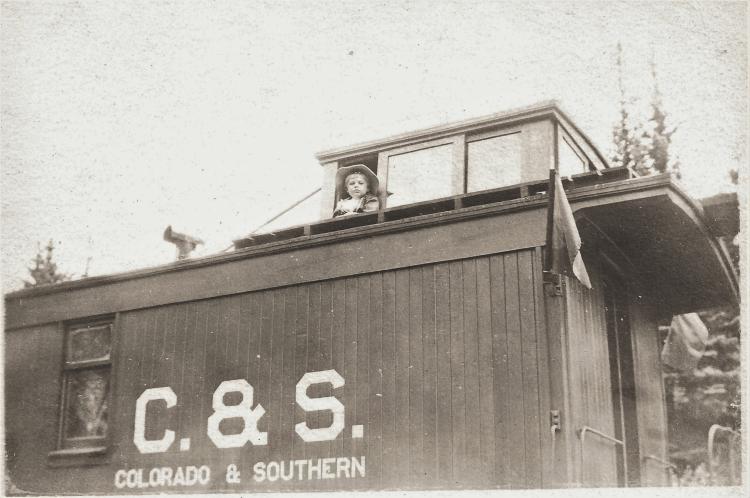 If the amateur photographer had remembered the first rule of photography, that cabooses are always more important than kids, we could better date both photos. Just a little bit lower framing and we could tell if the caboose was numbered 312 or 1009, meaning pre-1911 or post-1911. I'm betting that it would be numbered 312. I don't think there is any doubt which rebuilt caboose this is--only 312/1009 had the faux "quarter round" corners. The corners aren't round, they are square; the marker bracket is notched into the corner at a 45 degree angle. There are vertical trim pieces on the side and end to suggest passenger car style quarter round. Cabooses 306/1005 and 310/1008 had true quarter round corners. Caboose 312/1009 is the only rebuild to have the faux quarter round corners, a feature it carried up until abandonment, though its letter board fascia got skinny in later years. What I find exciting about the photo is that it may be one of the earliest photos of a C&S caboose rebuild. Look at the details: --There is a small residual chalk mark along the bottom of the "S" to the second period and beyond, suggesting that the car shops had just applied the small C&S block monogram. --There is no ladder on this, the A-end platform. --The little tension rod or brace from the cupola to roof, over the lateral running board, is present only on the long roof side of the cupola. In Derrell's "Eight Wheel Caboose" thread, the consensus was that the brace kept the cupola side from moving and jaming the sliding side cupola window. --There are lateral roof walks on both sides of the cupola, unlike that of 304/1003, which Derrell so beautifully modeled (photos on Keith's "Caboose 1000" thread). --The ends have the modern horizontal lower fascia edge, meaning the end windows are fixed and cannot be opened. --There is a little toe board under the cupola windows, connecting the lateral roof walks, like in the 1912 photos of caboose 1007. --And look closely Keith: There is only one grab iron visible on the entire cupola roof. It doesn't run the full length of the side of the cupola roof, but is centered over the left cupola window, the one that slides open. It suggests that the 'round the cupola running boards were not intended to allow trainmen to circumnavigate the cupola, but rather to enter and leave the cupola from/to the roof, via the single opening side window. A photo of the same car, lettered as 1009, in a Carl Reich photo at Grant, dated to 1913 (from the Klingers' Platte Canon Meomories . . .):  Anyway, I'm pretty much convinced that the two little photos are from the summer of 1909 or 1910, based on the features that I've noted above. Close enough that my Overland Sn3 long body caboose will be built out as in the photos and numbered 312. Maybe I'll put a little girl (or is it a boy??) peering out the side cupola window! I'll try to curb my enthusiasm and hope that all of you will share any thoughts that you might have.
Jim Courtney
Poulsbo, WA |
Re: Vintage photos, C&S engine 9 and caboose 312/1009, c1909-11
|
Jim,
What a nice find! I really like the caboose picture. That chalk line from the "S" to the "." is classic. How long do you think that would have lasted exposed to the elements? Probably till the first thunderstorm! Nice write up and detective work too. Doug
Doug Heitkamp
Centennial, CO |
Re: Vintage photos, C&S engine 9 and caboose 312/1009, c1909-11
|
But, is it a little girl or little boy?
Jim Courtney
Poulsbo, WA |
Re: Vintage photos, C&S engine 9 and caboose 312/1009, c1909-11
|
Bruce Jenner, the early years.
Doug Heitkamp
Centennial, CO |
Re: Vintage photos, C&S engine 9 and caboose 312/1009, c1909-11
|
If you look closely at the face it kind of looks like a boy Remember that mothers of that era tended to dress young boys in prissy outfits.Google Buster Brown.
|
Re: Vintage photos, C&S engine 9 and caboose 312/1009, c1909-11
|
In reply to this post by Doug Heitkamp
Doug,
Speaking of transgendered images, your coincidental posting of the photo of funky number 13, dated to 1910, may have firmed up the dates of my two little photos and pushed them further back in time:  That has to be number 9 behind number 13. It is a Cooke 2-6-0 (no air tanks between the domes) and number 9 was the only B-3-C with rounded dome covers. Notice that number 9's headlight bracket in your photo is fully cantilevered out over the pilot, with the "way out front" headlight appearance. The photos I posted above, including the McClure side view of number 9 at Baileys, show the headlight bracket only moved partially forward on top of the smoke box. Thus, if your photo is correctly dated to 1910, then the photos above, including the McClure's, are likely earlier, 1908 or 1909. If true, then the caboose photo would, indeed, be the earliest known photo of a rebuilt C&S caboose. You buying this argument?
Jim Courtney
Poulsbo, WA |
Re: Vintage photos, C&S engine 9 and caboose 312/1009, c1909-11
|
This post was updated on .
In reply to this post by Doug Heitkamp
At maximum resolution on my scanner (4800 dbi) the child's gender seems more apparent:
 Given the fancy shoes and the decorative pattern on the thigh of the stockings (a dragonfly?), she looks like a little girl. On the other hand, Doug could be right . . . Bruce Jenner is the only fair haired member of the Kardashian Klan, so I guess it could be him. Meanwhile, I've been pondering the headlight (pretty cool, given the original headlight image is smaller than a dime!): 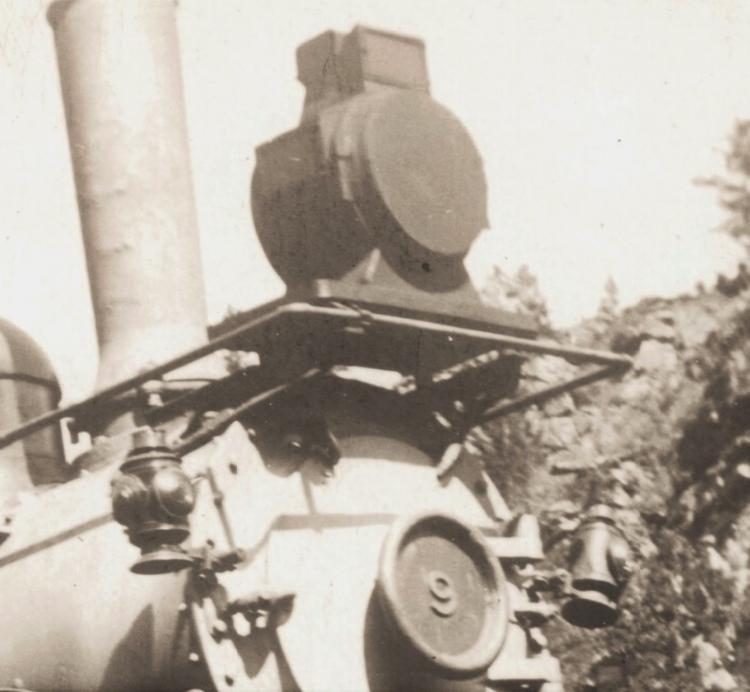 Is that really a sheet metal cover over the front glass, or is the glass just filthy from soot, in need of cleaning? For most of number 9's C&S career she was usually assigned to passenger service on the Platte Canon segment of the South Park Division. The Leadville Passenger, Denver to Como and back; the Fish Train, Denver to Grant in the afternoon and back to Denver the next morning; day excursions out of Denver, Denver to Pine and back. If trains were double headed, she was usually the road engine, the helpers in the lead, with much coal soot blowing back on the front of number 9:  http://digital.denverlibrary.org/cdm/fullbrowser/collection/p15330coll22/id/78189/rv/singleitem Both engines in this McClure view from DPL have obscure headlight fronts, and the headlight on helper number 46 has the protective screen down. On the other hand, all of the passenger runs described above were pretty much always daylight runs, so number 9 was likely seldom out after dark. So maybe a sheet metal protective cover over the headlight glass was standard operating practice on the passenger engines. Silly of me--I always thought that the headlight "shade" on the first decade engines was to dim lighted headlights at night, at opposing meets. It only now occurrs to me that they may have been used to protect the headlight glass from getting dirty or broken when engines were in helper duty, on multi-engine trains. Helpers on runs like that over the pass, through Alpine Tunnel, would likely become filthy after only one trip. Consider number 7 at Como, also a first decade passenger engine on the Denver to Como segment:  I've always interpreted this as sunlight reflecting off the headlight glass, but the sheen of reflected light from the sheet metal front of the box headlight seems identical. Could this be another metal headlight glass cover? Today, it is all the rage to install TCS light decoders in our brass narrow gauge engines, and tiny 1.5 volt bulbs in the headlights, markers and cab interiors, so we can turn each off and on, along with our sounds. But during the narrow gauge era, even up to the 1930s, headlights were likely never on during the day (the convention of headlights to warn pedestrians or vehicles during day light hours didn't become common until after WWII). Markers weren't used during the day, flags were the norm. At night, only the lead engine of a multi-engine train used the headlight and had markers lit. And it is unlikely that the cab interior lights were on very often at night, as they would have interfered with the engine crew's night vision (at least that was the practice when I was a head end brakeman on the Rock Island, in the late 1960s). So, it occurred to me that rather than spend a bunch of tedious time installing tiny bulbs into various orifices of my engines, why not just cover the headlights on all but one or two. A small rectangle of black 0.010 inch thick Evergreen styrene should do the trick!  Minimal wiring, and the covers would protect the headlight glass from damage:  Just saying . . .
Jim Courtney
Poulsbo, WA |
Re: Vintage photos, C&S engine 9 and caboose 312/1009, c1909-11
|
Google Buster Brown.Buster comics from the TOC show he wasn't an effeminant sissy-but the clothes he wore and his haircut make him look like a girl.BTW he had a girlfriend and you can tell the difference between them.I think the "kid" looks a little like Spanky McFarland.
|
Re: Vintage photos, C&S engine 9 and caboose 312/1009, c1909-11
|
Jim, if the location was Chama, this could have been my Grandfather. Even odds on the sex, dragonfly or no.
Keith Hayes
Leadville in Sn3 |
Re: Vintage photos, C&S engine 9 and caboose 312/1009, c1909-11
|
In reply to this post by Jim Courtney
I see no coal in the 7's tender... I see no external spark arrester on the stack. No cone, no Ridgway. During its oil days, perhaps?
Rick |
Re: Vintage photos, C&S engine 9 and caboose 312/1009, c1909-11
|
In reply to this post by Keith Hayes
Keith,
Speaking of location, anyone have any idea where the two snapshots were taken? The only place that I can think of, that an idle passenger engine would be spotted on the same track as a stock car, is at Grant. If number 9 were the power for the Fish Train, she would have turned her train on the wye after arrival at Grant and then be spotted with her train for the night, awaiting departure the next morning. The siding to the north of the mainline, opposite the telegraph office, freight house and wye, had a stock yard about midway on the siding, opposite the wye. A couple of photos in the Klinger's book show number 6 on the Fish Train about 1912, awaiting morning departure for Denver. In the background are some stock cars, spotted on the same siding, at the stock yards. Can anyone think of any other possible location? As to the gender of the child, I take Robert's point about the "Buster Brown" fashion of the era for boys. After futher study, I really can't decide the gender of the child---and I'm a Pediatrician! Jim
Jim Courtney
Poulsbo, WA |
«
Return to C&Sng Discussion Forum
|
1 view|%1 views
| Free forum by Nabble | Edit this page |

